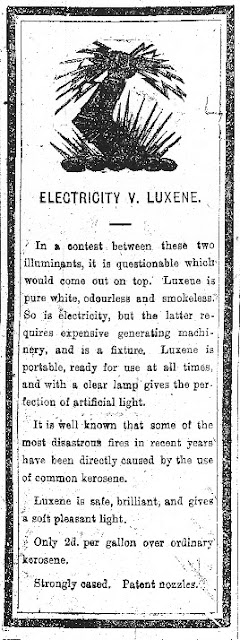These were bought in an antiques shop on Garnet Road in Westmere named Babushka Antiques. As I said to the proprietor there yesterday, antique shops are beaten only by second-hand bookstores as places where my wallet gets lighter.
Above is a card sent from Carterton 20 December 1913, from C Dudson to "dear Mrs Draper & family."
No date on this one, and nothing on the back. Card from Cambridge, Waikato.
A colourised photo of the Square at Feilding, lower North Island, with the date above 22 September 1907. Sent to Miss N Draper in "Judgford via Wellington" from Dannevirke.
"Dear Kate,
I don't think I ever answered your last postcard. Lily (?) was at a dance in Ngapaeruru last Friday night. We played a hockey match against Woodville last Saturday. They beat two to nil. How are you getting on down there, you ought to come up, have a holiday, yours ever,
Nellie."
Old Government House, Auckland. The card was received in Napier 26 December 1904, sent to Miss Baker there. "Love and best wishes for Xmas from Florence."
Waikato Hospital. No date on the postcard, but there's a tantalising impression of a postmark on the left side, as if the card had been under another one as the postmark had been slammed down. Unreadable, though.
"Dear Annie,
You might post me down my big prayer Book as I am thinking of goingb to Auckland at Easter. There is an Excursion from Hamilton to Rotorua & back on Good Friday, it is six shillings return from Hamilton. Jane is going if you & Eva would like to go. Write to Dave and their [sic] will be a chance of your accompanying him. I was at Church today & I got a piece of Palm which I have not had for years."
Another undated card, this one of Wellington Hospital. Below, a detail from the card, three-wheeled carts for invalids?
Last but not least -- Ngauruhoe having an episode.
"Dear Mrs Goldie,
This PC is a volcano we passed on out journey to Wellington. I don't care for Wellington at all, it was awfully windy & dusty while we were there. Coming from Wellington to Lyttleton Mother & I were very sick. Today I am going to a party & also the Fete, so I hope it keeps fine. Father goes to Court every morning & to Lyttleton once a month. I have been to Burwood, Linwood, Sydenham since I have been in Addington. We have been here a week."
It's anyone's guess when the postcard dated from. There's no date on the card, and Ngauruhoe had a busy time of it in the first two decades of last century.
An outburst of smoke and ash from Ngauruhoe occurred at 9.30 a.m. on the 22nd. The snow on the north-east side is completely covered with falling ash, and the crater seems pretty active.
Otago Witness 30 November 1904
[Ruapehu active.] Ngauruhoe volcano, which is adjacent, is also very active, sending out volumes of smoke and ash, ... there is unusual volcanic activity at present.
Poverty Bay Herald, 22 March 1906
The Ngauruhoe volcano, Taupo, which has been showing signs of increased activity during last week, gave a line display on Thursday and Friday. Huge volumes of ash and steam were pouring. out of the two craters of the summit, rising to a height of about 4000 ft above the cone, and forming a beautiful sight. The eastern side of the crater has been blown away, and this has altered the shape of the summit.
Poverty Bay Herald 14 February 1907
WELLINGTON, to-day. The post office has received advice from the postmaster at Karioi, stating that Mt. Ngauruhoe is in active eruption. Large clouds of smoke are being emitted and sulphurous dust has fallen, covering the ground in a thin coating to a depth of one-sixteenth of an inch. [Lasted through to August].
Bush Advocate 9 March 1909
AUCKLAND, January 27. The Herald's Taupo correspondent telegraphed last night that during the past week Ngauruhoe volcano has been getting more active than usual, and this morning at 10.45 there was a magnificent outburst from the crater which sent up columns of smoke and ash to a height of about 6000 feet. The ash was carried by the light south wind across Tongariro and soon obscured it from view. The ash is now drifting across the sky in a northerly direction like a black pall. The Ohinepango and Waihoponu rivers are now a black swirl of water.
Hawera & Normanby Star, 27 January 1910
NGAURUHOE IN VIOLENT ERUPTION.
AUCKLAND, October 26. After many signs of activity, Ngauruhoe broke out into violent eruption last week, culminating in an alarming outburst on Tuesday night. Huge black clouds ol ash, steam, and tongues of lurid flame were seen in the early part of the evening issuing from the crater, to the accompaniment of the deep rumbles of subterranean explosions. Earth tremors were frequently felt, causing a good deal of apprehension in the Native settlements near the base of the mountain. A large area of open country on the windward side, together with the snow fields of Tongariro, has been covered with a deposit of light pumice ash. The night staff at the Waimanno railway station and residents who witnessed these displays on Saturday and Tuesday night, state that Ngauruhoe luls never before shown such unabated violence. Clouds have obscured the upper heights of the volcano for the last few days, and though an occasional rumble is heard, it is impossible to say if the eruption continues on the same scale.
Ashburton Guardian 27 October 1917
























































